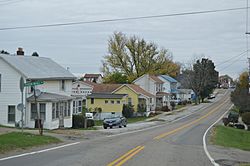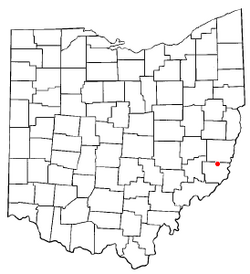Beallsville, Ohio facts for kids
Quick facts for kids
Beallsville, Ohio
|
|
|---|---|
|
Village
|
|

Ohio Avenue
|
|

Location of Beallsville, Ohio
|
|

Location of Beallsville in Monroe County
|
|
| Country | United States |
| State | Ohio |
| County | Monroe |
| Township | Sunsbury |
| Area | |
| • Total | 0.36 sq mi (0.94 km2) |
| • Land | 0.36 sq mi (0.94 km2) |
| • Water | 0.00 sq mi (0.00 km2) |
| Elevation | 1,253 ft (382 m) |
| Population
(2020)
|
|
| • Total | 355 |
| • Estimate
(2023)
|
347 |
| • Density | 977.96/sq mi (377.77/km2) |
| Time zone | UTC-5 (Eastern (EST)) |
| • Summer (DST) | UTC-4 (EDT) |
| ZIP code |
43716
|
| Area code(s) | 740 |
| FIPS code | 39-04542 |
| GNIS feature ID | 2398057 |
Beallsville (/ˈbɛlzvɪl/ BELLZ-vil) is a village in Monroe County, Ohio, United States. As of the 2020 census, the population was 355. The village gained national attention by losing more than 1% of its population killed in action in the Vietnam War, the worst per-capita loss of life experienced by any place in the country.
Two former coal mines owned by Murray Energy, Powhatan No. 6 mine and Century Mine, are located near Beallsville.
History
During the period of active American participation in the Vietnam War in the 1960s, Beallsville gained brief notoriety for the loss of five of its citizens in the conflict — a traumatic rate of loss for the village of fewer than 500 residents that was estimated at 75 times the national average. The plight of the community drew wire service coverage and was the subject of a lengthy illustrated spread in the glossy left-wing magazine Ramparts. Moved by the magnitude of the loss, Congressman Clarence Miller made a formal request to Secretary of Defense Melvin Laird and President Richard Nixon to withdraw the village's other six servicemen from combat, which was denied.
A sixth of the village's sons fell in combat on March 9, 1969, cementing the community's tragic distinction of having the highest percentage rate of loss in the Vietnam War of any town in America.
Geography
According to the United States Census Bureau, the village has a total area of 0.36 square miles (0.93 km2), all of it land.
Demographics
| Historical population | |||
|---|---|---|---|
| Census | Pop. | %± | |
| 1830 | 50 | — | |
| 1840 | 100 | 100.0% | |
| 1850 | 276 | 176.0% | |
| 1870 | 324 | — | |
| 1880 | 391 | 20.7% | |
| 1890 | 512 | 30.9% | |
| 1900 | 554 | 8.2% | |
| 1910 | 564 | 1.8% | |
| 1920 | 555 | −1.6% | |
| 1930 | 479 | −13.7% | |
| 1940 | 450 | −6.1% | |
| 1950 | 410 | −8.9% | |
| 1960 | 441 | 7.6% | |
| 1970 | 452 | 2.5% | |
| 1980 | 601 | 33.0% | |
| 1990 | 464 | −22.8% | |
| 2000 | 423 | −8.8% | |
| 2010 | 409 | −3.3% | |
| 2020 | 355 | −13.2% | |
| 2023 (est.) | 347 | −15.2% | |
| U.S. Decennial Census | |||
2010 census
As of the census of 2010, there were 409 people, 174 households, and 113 families living in the village. The population density was 1,136.1 inhabitants per square mile (438.7/km2). There were 196 housing units at an average density of 544.4 per square mile (210.2/km2). The racial makeup of the village was 97.8% White and 2.2% from two or more races.
There were 174 households, of which 31.6% had children under the age of 18 living with them, 43.7% were married couples living together, 13.2% had a female householder with no husband present, 8.0% had a male householder with no wife present, and 35.1% were non-families. 30.5% of all households were made up of individuals, and 12.6% had someone living alone who was 65 years of age or older. The average household size was 2.35 and the average family size was 2.90.
The median age in the village was 39.8 years. 22.5% of residents were under the age of 18; 9.1% were between the ages of 18 and 24; 25.9% were from 25 to 44; 29.1% were from 45 to 64; and 13.4% were 65 years of age or older. The gender makeup of the village was 48.9% male and 51.1% female.
Notable people
- Merriman Colbert Harris, Civil War soldier and Methodist Episcopal Church Missionary Bishop
- Dustin Nippert, professional baseball player
See also
 In Spanish: Beallsville (Ohio) para niños
In Spanish: Beallsville (Ohio) para niños

